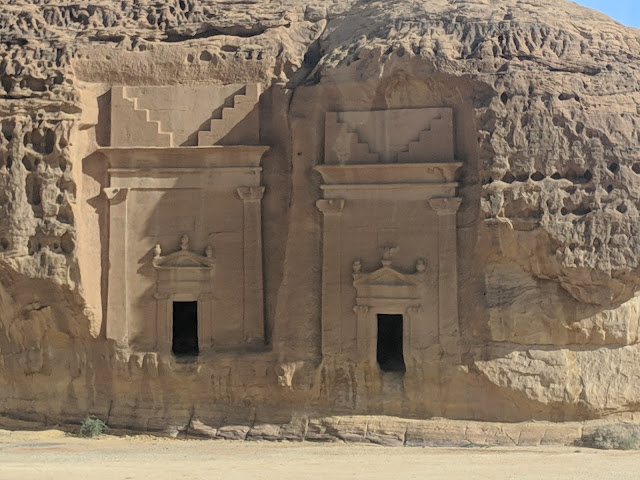In the 1970s I had the opportunity to visit the ancient city of Petra in Jordan. For those not familiar with the name, you might recall it from the ending of Indiana Jones and the Last Crusade. Back then it had few tourists and there was only one small hotel at the top of the canyon path that leads to the site. I'm afraid to think of what it looks like now. I'm sure you have to run a gauntlet of souvenir shops selling trinkets made somewhere else.
Later in life I learned that there were similar carved structures within Saudi Arabia itself and that they were related to those at Petra. The site here is called Mada'in Saleh and, while Petra was the capital of the Nabataean empire, Mada'in Saleh was the secondary, southern capital at what was a fork in their trade routes. One route led to Petra and the other led toward Mesopotamia. The ancient name for Mada'in Saleh was Al Hijra.
Note that Mada'in Saleh is closed to the public until 2020, at the earliest, as the government tries to build tourist infrastructure around the region. We were given royal permission to access the site.
The site has been settled for thousands of years, but it is famous for the Nabataean era because they were the ones that did the stone carvings of tombs into the surrounding rock formations. The most famous tomb and image is this one of the lone temple...
 |
| courtesy Mike Miller |
There are over 130 tombs located so far. In 2017 the first intact tomb was found with skeletons still inside. This tomb is, of course, off limits as its contents are studied.
Tomb carving was influenced by several factors. Bigger tombs were for richer families. Poor families had just a hole carved in the rock or were placed on carved niches exposed to the elements. The background of the family and era also influenced what was carved on the front. Some have Egyptian elements, some have Greek, Roman, Assyrian, etc. The direction or side of the rock they were carved on also made a difference. Richer folk purchased the side that was facing away from the wind so that the tomb would not be eroded by wind and sand storms. Poor folk took the wind sides.
In general, the tombs surrounded a large residential area that occupied a central flat area. This area is currently fenced off for archaeological digging/research. At the time, the area was more fertile and boasted 130 wells.
Unlike any at Petra, the tombs here actually had 'plaques' at the top with inscriptions of owner, their positions, the carver, and other details. Many held military ranks, leading to theories that this served as a military center for protecting trade routes.
Inside you might find a room or two, body niches, or some platforms. The guide told us that while the family was still alive and burying generations, they would use a wood door to close off the tomb. Once the last member of the family died, the tomb would be sealed off with a carved stone to fit the entrance and lime.
In 2008, UNESCO's World Heritage Committee (WHC) agreed on Madain Saleh site to join the World Heritage List. Thus, the site has become the first archeological site in Saudi Arabia to be enlisted by the WHC of the UNESCO.
The Nabataean wealth and influence came from trade of spices, frankincense, and myrrh along their trade routes. The fall of their empire came at the hands of the Romans, who conquered the region and started to trade via water (Red and Arabian Seas) versus over land. The city declined and was eventually pretty much abandoned.
 |
| original Ottoman fort |
The Ottomans took over the region in the 1500s and built a fort with a well. It still served as a waystation for pilgrims going on Hajj. Eventually, in the early 1900s, a railroad was built to reach Mecca and the station became one of the stops. More buildings were added to the site. During World War I, the railway was blown up farther north by revolting Arabs and Lawrence of Arabia.
I fell in love with the rocky formations of the region.
Not historical bones and perhaps not even human.
Sahary Resort is one of the first completed with more expansion underway. They have bedouin tent bungalows (think yurt) to reserve and the dining is in this luxurious dining tent.
Up next, our afternoon of four-wheeling through the desert!

.png)















